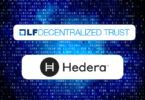Today Hedera Hashgraph announced it has raised $100m for its public distributed ledger platform. The money came from institutions and high net worth individual investors. Hedera is of note because it’s the closest thing to an institutional or enterprise public blockchain. It also stands out because it’s controversial in many ways.
Back in April when Ledger Insights spoke to CEO Mance Harmon, the likelihood was that they would only do a private token sale. However, today they announced a $20m crowdsale. That said, it will be restricted to accredited investors and uses SAFT.
Hedera’s conservative stance is reflected in the terms of that sale. Tom Trowbridge, President of Hedera said: “These are the same terms under which management and employees have invested over $10 million in the most recent round. Separately, the majority of the tokens granted to the co-founders vest in four to six years. This clearly demonstrates our long-term belief in, and commitment to the growth of Hedera.”
“We are seeing tremendous demand for our fast, fair, and secure public network,” said Mance Harmon, co-founder and CEO of Hedera. “With this funding, we will be able to accelerate development of key services to be provided by Hedera – including a cryptocurrency, file storage service, and smart contract platform – to help make it not only what we believe is the fastest and most secure public ledger available, but also the most feature-rich for developers looking to build highly decentralized apps.”
The team and technology
Most public blockchains are run by foundations, whereas Hedera is very much a for-profit organization.
The team behind permissioned ledger Swirlds founded Hedera, and it uses technology developed by co-founder Leemon Baird. Swirlds was one of the technologies used for the distributed ledger project CULedger which was developed by a US group of credit unions.
One of the most controversial aspects is the intellectual property in the core algorithm and technology is owned by Swirlds and licensed to Hashgraph. When talking to enterprises about selecting a distributed ledger technology (DLT), using open source software is a common DLT criterion.
The reaction from the cryptocurrency community is quite extreme. This is a sample Reddit post: “It’s also vile proprietary software whose owners refuse to opensource it. I would avoid it like the plague.”
While maintaining rights over Swirlds IP, they’re making use of Ethereum’s open-source Solidity smart contract language. The platform incorporates a cryptocurrency and file storage similar to second and third generation blockchains.
Hedera is not a blockchain it’s a hashgraph. The company claims it can process hundreds of thousands of transactions per second on a single shard which is a group of servers. Concerning consensus, it uses asynchronous Byzantine Fault Tolerance, and hence they assert the platform is less vulnerable to denial of service attacks.
On distributed ledgers the ordering of transactions is essential. An extreme example is a share price purchase in a volatile situation. For example, if the first transaction gets a price of $10 and the second sells for $15 fractions of a second later, it matters if your transaction is first. This is referred to as fairness. Swirlds published formal proofs of its fairness, though there has been a little debate on the topic.
Governance
Another controversial aspect is the network’s governance. In the public blockchain space governance is a big headache. Hedera’s solution is to make their platform a public permissioned network.
The data is on a public network, but the governance of the system is permissioned. One of the reasons is to prevent the hard forks that have happened with both Bitcoin and Ethereum.
Hedera plans a Council Governance Model. This will be made up of 39 organizations which are leaders in their respective fields. These large organizations have experience of running major business processes, and they’re widely trusted. The plan is to have them spread geographically and across industries, so they bring different perspectives. They won’t be the only ones to host nodes.
Theoretically there’s a lot of sense in the thinking, but there are potential challenges. Hedera hasn’t yet announced the organizations. Many candidate organizations may perceive being one of the 39 to be too risky given Hedera is a cryptocurrency platform. They have not yet announced any names. But for those willing to take the risk there could also be a substantial reward.
Then there’s the issue of possibly choosing one company in a particular sector. One of the most significant resistance points to the Quorum blockchain is other banks don’t want to use JP Morgan’s blockchain. Distributed ledger is about collaboration, and if there isn’t enough representation from an industry that could be problematic. A solution might be to have blockchain consortia as the sector’s representative organization.
Another issue is the politics of prominent organizations and the potential for slow decision making with a large governance council. Also distributed ledger is about tomorrow’s business models. Historically incumbents struggle to adapt to disruptive forces. So do you want incumbents controlling the direction?
Conclusion
In the public blockchain space there are a few exceptional companies and many me-toos. Hedera is certainly unique and will unquestionably be divisive. That’s often a good thing. The underlying technology is potentially a huge advantage. The governance is controversial and will be challenging but could work.
The target market appears to be enterprises. Large companies often work with major consultancies. And many of them prefer to work with open source software. So the proprietary aspect of the software is perhaps the most controversial and could be Hedera’s Achilles Heel. Hedera is going to be an interesting one to watch.






